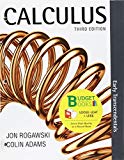
Loose-leaf Version for Calculus: Early Transcendentals Combo 3e & WebAssign for Calculus: Early Transcendentals 3e (Life of Edition)
3rd Edition
ISBN: 9781319019846
Author: Jon Rogawski, Colin Adams
Publisher: W. H. Freeman
expand_more
expand_more
format_list_bulleted
Question
Chapter A, Problem 42E
To determine
To prove: M is not divisible by any of the prime and shows that every number has a prime factorization to prove that there exist infinitely many prime numbers. This argument was advanced by Euclid in the Elements.
Expert Solution & Answer
Want to see the full answer?
Check out a sample textbook solution
Students have asked these similar questions
please do Q3
Use the properties of logarithms, given that In(2) = 0.6931 and In(3) = 1.0986, to approximate the logarithm. Use a calculator to confirm your approximations. (Round your answers to four decimal places.)
(a) In(0.75)
(b) In(24)
(c) In(18)
1
(d) In
≈
2
72
Find the indefinite integral. (Remember the constant of integration.)
√tan(8x)
tan(8x) sec²(8x) dx
Chapter A Solutions
Loose-leaf Version for Calculus: Early Transcendentals Combo 3e & WebAssign for Calculus: Early Transcendentals 3e (Life of Edition)
Ch. A - Prob. 1PQCh. A - Prob. 2PQCh. A - Prob. 3PQCh. A - Prob. 4PQCh. A - Prob. 1ECh. A - Prob. 2ECh. A - Prob. 3ECh. A - Prob. 4ECh. A - Prob. 5ECh. A - Prob. 6E
Ch. A - Prob. 7ECh. A - Prob. 8ECh. A - Prob. 9ECh. A - Prob. 10ECh. A - Prob. 11ECh. A - Prob. 12ECh. A - Prob. 13ECh. A - Prob. 14ECh. A - Prob. 15ECh. A - Prob. 16ECh. A - Prob. 17ECh. A - Prob. 18ECh. A - Prob. 19ECh. A - Prob. 20ECh. A - Prob. 21ECh. A - Prob. 22ECh. A - Prob. 23ECh. A - Prob. 24ECh. A - Prob. 25ECh. A - Prob. 26ECh. A - Prob. 27ECh. A - Prob. 28ECh. A - Prob. 29ECh. A - Prob. 30ECh. A - Prob. 31ECh. A - Prob. 32ECh. A - Prob. 33ECh. A - Prob. 34ECh. A - Prob. 35ECh. A - Prob. 36ECh. A - Prob. 37ECh. A - Prob. 38ECh. A - Prob. 39ECh. A - Prob. 40ECh. A - Prob. 41ECh. A - Prob. 42E
Knowledge Booster
Similar questions
- Find the indefinite integral by making a change of variables. (Remember the constant of integration.) √(x+4) 4)√6-x dxarrow_forwarda -> f(x) = f(x) = [x] show that whether f is continuous function or not(by using theorem) Muslim_mathsarrow_forwardUse Green's Theorem to evaluate F. dr, where F = (√+4y, 2x + √√) and C consists of the arc of the curve y = 4x - x² from (0,0) to (4,0) and the line segment from (4,0) to (0,0).arrow_forward
- Evaluate F. dr where F(x, y, z) = (2yz cos(xyz), 2xzcos(xyz), 2xy cos(xyz)) and C is the line π 1 1 segment starting at the point (8, ' and ending at the point (3, 2 3'6arrow_forwardCan you help me find the result of an integral + a 炉[メをメ +炉なarrow_forward2 a Can you help me find the result of an integral a 아 x² dxarrow_forward
- Please help me with this question as I want to know how can I perform the partial fraction decompostion on this alebgric equation to find the time-domain of y(t)arrow_forwardPlease help me with this question as I want to know how can I perform the partial fraction on this alebgric equation to find the time-domain of y(t)arrow_forwardEvaluate F³ - dr where ♬ = (4z, -4y, x), and C' is given by (t) = (sin(t), t, cos(t)), 0≤t≤ñ .arrow_forward
arrow_back_ios
SEE MORE QUESTIONS
arrow_forward_ios
Recommended textbooks for you
 Calculus: Early TranscendentalsCalculusISBN:9781285741550Author:James StewartPublisher:Cengage Learning
Calculus: Early TranscendentalsCalculusISBN:9781285741550Author:James StewartPublisher:Cengage Learning Thomas' Calculus (14th Edition)CalculusISBN:9780134438986Author:Joel R. Hass, Christopher E. Heil, Maurice D. WeirPublisher:PEARSON
Thomas' Calculus (14th Edition)CalculusISBN:9780134438986Author:Joel R. Hass, Christopher E. Heil, Maurice D. WeirPublisher:PEARSON Calculus: Early Transcendentals (3rd Edition)CalculusISBN:9780134763644Author:William L. Briggs, Lyle Cochran, Bernard Gillett, Eric SchulzPublisher:PEARSON
Calculus: Early Transcendentals (3rd Edition)CalculusISBN:9780134763644Author:William L. Briggs, Lyle Cochran, Bernard Gillett, Eric SchulzPublisher:PEARSON Calculus: Early TranscendentalsCalculusISBN:9781319050740Author:Jon Rogawski, Colin Adams, Robert FranzosaPublisher:W. H. Freeman
Calculus: Early TranscendentalsCalculusISBN:9781319050740Author:Jon Rogawski, Colin Adams, Robert FranzosaPublisher:W. H. Freeman
 Calculus: Early Transcendental FunctionsCalculusISBN:9781337552516Author:Ron Larson, Bruce H. EdwardsPublisher:Cengage Learning
Calculus: Early Transcendental FunctionsCalculusISBN:9781337552516Author:Ron Larson, Bruce H. EdwardsPublisher:Cengage Learning

Calculus: Early Transcendentals
Calculus
ISBN:9781285741550
Author:James Stewart
Publisher:Cengage Learning

Thomas' Calculus (14th Edition)
Calculus
ISBN:9780134438986
Author:Joel R. Hass, Christopher E. Heil, Maurice D. Weir
Publisher:PEARSON

Calculus: Early Transcendentals (3rd Edition)
Calculus
ISBN:9780134763644
Author:William L. Briggs, Lyle Cochran, Bernard Gillett, Eric Schulz
Publisher:PEARSON

Calculus: Early Transcendentals
Calculus
ISBN:9781319050740
Author:Jon Rogawski, Colin Adams, Robert Franzosa
Publisher:W. H. Freeman


Calculus: Early Transcendental Functions
Calculus
ISBN:9781337552516
Author:Ron Larson, Bruce H. Edwards
Publisher:Cengage Learning